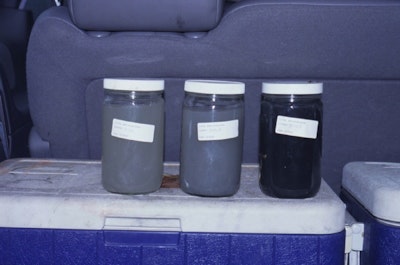Interested in Education/Training?
Get Education/Training articles, news and videos right in your inbox! Sign up now.
Education/Training + Get AlertsTroubleshooting a septic tank? Is the ATU or a media filter working properly? Checking the dissolved oxygen is key to diagnosing performance.
Dissolved oxygen (DO) is a measure to determine how much oxygen is in wastewater. DO is measured in milligrams per liter (mg/L) or parts per million (ppm). The three oxygen states in septic systems are aerobic, anaerobic and anoxic. The term aerobic is defined as having molecular oxygen (free oxygen, O2) as a part of the environment, or a biological process that occurs only in the presence of molecular oxygen. An anoxic condition is the absence of molecular oxygen, but the microbes can utilize oxygen bound in other molecules, such as nitrate (NO3-) and sulfate (SO4+). Anaerobic is the condition in which all wastewater and/or effluent constituents are in their reduced form, meaning there are no oxidants present.
In aerobic treatment units, media filters and other aerobic treatment processes we expect to see a DO greater than 1 mg/L to indicate there is sufficient DO for the aerobic organisms. On the other hand, a typical value for DO in a septic tank is less than 1 mg/L. This is because septic tank microbes assimilate the waste constituents in the absence of a respiration process and are referred to as anaerobic microbes. The anaerobic bacteria do not thrive in environments with free oxygen. Water entering the septic tank has dissolved free oxygen, which must be removed by the oxygen requirements of the wastewater so the anaerobic bacteria can survive. As the system matures, the anaerobic bacteria become more efficient. The oxygen demand in the system rapidly removes free oxygen entering with the influent and maintains the anaerobic environment. The greater removal rates of biochemical oxygen demand (BOD) and total suspended solids (TSS) are achieved under this anoxic environment.
Anoxic conditions are often required for systems designed to denitrify. Organisms in anoxic components are able to use the nitrate as an electron acceptor and release nitrogen in the form of nitrogen gas or nitrogen oxides.
There are many factors that influence the DO concentration in a system. If the water source from the home or facility has a low DO, then the amount of DO entering the onsite wastewater treatment system will be low. Low DO in the wastewater could also be caused by a high organic load. In aerobic treatment processes, high concentrations of organic matter, biochemical or chemical oxygen demand, fats, oils and grease, and nutrients will exhaust the oxygen in the wastewater. This is because the microbes present in the system require more oxygen to break down the increase in food..jpg)
High DO can be attributed to the water source and/or dilution due to leaking fixtures or infiltration. Also, if there is a significant amount of dead microbes in the system due to a chemical upset, a high DO may result. The microbes are not robust and are not depleting the oxygen supply. High DO can also occur in an anoxic tank if the recirculation rates are too high.
Sampling
The DO must be measured when the sample is taken or soon after because the level will decrease over time. Be careful not to add oxygen when sampling for DO or the sampling method may be faulty and give inaccurate readings. When sampling a tank it is best to sample in the middle or at the end of it to avoid mixing caused by wastewater entering the tank. Also avoid sampling near a pump due to the same concerns. With advanced treatment units, confirm with the product manufacturer and/or designer as to the proper sampling location and expected levels.
Test Kits
- CHEMetrics simple snap-and-read test kits measured by color comparison have a range from 0 to 12 mg/L.
.jpg) There are two kits, one that covers for 0 to 1 that will useful for septic tanks and 1 to 12 mg/L appropriate for testing advanced treatment units. A kit starts at around $55.
There are two kits, one that covers for 0 to 1 that will useful for septic tanks and 1 to 12 mg/L appropriate for testing advanced treatment units. A kit starts at around $55. - The Winkler method involves filling a sample bottle completely with water (no air is left to bias the test). The DO is then "fixed" using a series of reagents that form an acid compound that is titrated. DO field kits using the Winkler method are relatively inexpensive, especially compared to a meter and probe. Field kits run between $35 and $200, and each kit comes with enough reagents to run 50 to 100 DO tests. Replacement reagents are inexpensive, and you can buy them already measured out for each test in plastic pillows. Range of results is typically from 0 to 12 mg/L.
Meter and Probe
A dissolved oxygen meter is an electronic device that converts signals from a probe that is placed in the water. Most meters and probes also measure temperature. The probe is filled with a salt solution and has a selectively permeable membrane that allows DO to pass from the stream water into the salt solution. The DO that has diffused into the salt solution changes the electric potential of the salt solution and this change is sent by electric cable to the meter, which converts the signal to milligrams per liter.
.jpg) DO meters are expensive compared to field kits. Meter/probe combinations run between $500 and $1,200, including a long cable to connect the probe to the meter. The advantage of a meter/probe is that you can measure DO and temperature quickly at any point in the system that you can reach with the probe. You can also measure the DO levels at a certain point on a continuous basis. The results are read directly as milligrams per liter, unlike the titration methods, in which the final titration result might have to be converted by an equation to milligrams per liter.
DO meters are expensive compared to field kits. Meter/probe combinations run between $500 and $1,200, including a long cable to connect the probe to the meter. The advantage of a meter/probe is that you can measure DO and temperature quickly at any point in the system that you can reach with the probe. You can also measure the DO levels at a certain point on a continuous basis. The results are read directly as milligrams per liter, unlike the titration methods, in which the final titration result might have to be converted by an equation to milligrams per liter.
.jpg) However, DO meters are more fragile than field kits, and repairs to a damaged meter can be costly. The meter/probe must be carefully maintained, and it must be calibrated before each sample run and, if you are doing many tests, in between samplings. Because of the expense, a company might have only one meter/probe. This means that only one person can sample DO. Multiple staff can sample simultaneously with a field kit.
However, DO meters are more fragile than field kits, and repairs to a damaged meter can be costly. The meter/probe must be carefully maintained, and it must be calibrated before each sample run and, if you are doing many tests, in between samplings. Because of the expense, a company might have only one meter/probe. This means that only one person can sample DO. Multiple staff can sample simultaneously with a field kit.
About the Author
Sara Heger, Ph.D., is an engineer, researcher and instructor in the Onsite Sewage Treatment Program in the Water Resources Center at the University of Minnesota. She presents at many local and national training events regarding the design, installation and management of septic systems and related research. Heger is education chair of the Minnesota Onsite Wastewater Association (MOWA) and the National Onsite Wastewater Recycling Association (NOWRA), and serves on the NSF International Committee on Wastewater Treatment Systems. Send her questions about septic system maintenance and operation by email to kim.peterson@colepublishing.com.







